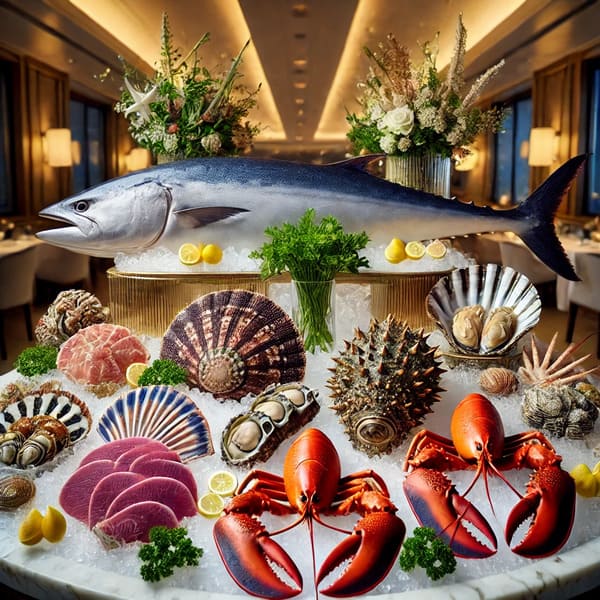Chamberlains of London – Seafood has long been consider a delicacy, but some varieties stand out due to their extraordinary price tags. These ocean treasures are not just meals, they are culinary experiences reserve for those who can afford their exclusivity. Among the most expensive seafood is the Bluefin Tuna, with a single fish fetching up to hundreds of thousands of dollars, particularly in Japan’s premium sushi markets.
Other notable mentions include Maine Lobster, King Crab from Alaska, and rare mollusks like Abalone and Geoduck. Each of these seafood varieties carries a hefty price tag due to their rarity, demand, and exceptional taste. For example, King Crab’s sweet and juicy meat makes it a popular choice for fine dining, while Abalone is revered in Asian cuisine for its symbolic and gastronomic value.
Factors Behind the Sky-High Prices
Several factors of expensive seafood contribute to the step cost of these seafood delicacies. Here’s a closer look at why they are so expensive:
- Scarcity and Habitat:
- Many of these seafood varieties are found in limited geographic regions or require specific environmental conditions to thrive. For instance, Abalone is cultivated in carefully control conditions, making it rare and expensive.
- Labor-Intensive Harvesting:
- Catching seafood like King Crab and Bluefin Tuna often involves dangerous and labor-intensive processes. Fishermen brave extreme weather and use specialized equipment to harvest these prized catches.
- High Demand in Luxury Markets:
- The demand for premium seafood in fine dining establishments and affluent markets drives up prices. Countries like Japan and China are key consumers of luxury seafood, where it’s often served in prestigious settings.
- Processing and Preservation:
- Some seafood requires intricate processing and preservation techniques. For instance, dried Abalone takes months to prepare and is considered a rare delicacy.
The Role of Seafood in Culinary Prestige
High-end seafood isn’t just about taste, it’s also a status symbol. In many cultures, serving premium seafood at events signifies wealth, respect, and hospitality. For example:
- Bluefin Tuna Auctions in Japan:
- At Tokyo’s famous Tsukiji fish market, Bluefin Tuna is auctioned off at jaw-dropping prices. The fish’s value is linked to its quality, size, and demand in the sushi industry.
- Lobster in Western Cuisine:
- Once considered a food for the poor, lobster is now a luxury item gracing the menus of Michelin-starred restaurants.
- Abalone in Asian Celebrations:
- Often referred to as the “truffle of the sea,” Abalone is a staple at weddings and Lunar New Year celebrations in China, symbolizing prosperity and good fortune.
“Also Read: A Simple Way to Cook Black Pepper Mussels: Restaurant-Style Recipe at Home”
How to Experience Premium Expensive Seafood
For those eager to taste these high-end seafood options, here are some tips to enjoy them responsibly and authentically:
- Source from Trusted Suppliers:
- Ensure the seafood you purchase comes from reputable vendors who adhere to sustainable fishing practices. This guarantees freshness and ethical consumption.
- Opt for Simple Preparations:
- The natural flavors of premium seafood are best enjoy with minimal seasoning and cooking. Sashimi, steam dishes, or light grilling are popular methods.
- Pair with Complementary Wines:
- Enhance the dining experience by pairing seafood with the right wine. For instance, lobster pairs well with Chardonnay, while King Crab complements Sauvignon Blanc.
- Explore Fine Dining Restaurants:
- Many fine dining establishments specialize in showcasing these delicacies, offering expertly craft dishes that highlight their unique flavors.
Sustainability and Ethical Consumption
While indulging in luxurious seafood, it’s crucial to consider the environmental impact of your choices. Overfishing and unsustainable practices have put many species, including Bluefin Tuna and Abalone, at risk of extinction. Organizations and governments worldwide are now working to regulate fishing quotas and promote sustainable aquaculture.
As consumers, choosing sustainably sourced seafood not only supports marine conservation but also ensures these treasures remain available for future generations. Opt for seafood certified by organizations like the Marine Stewardship Council (MSC) or Aquaculture Stewardship Council (ASC) to make eco-conscious choices.
